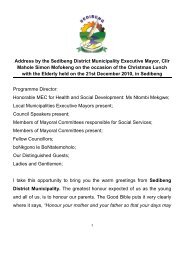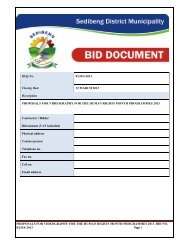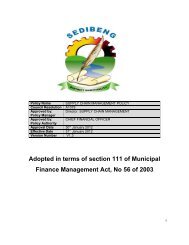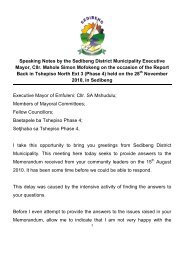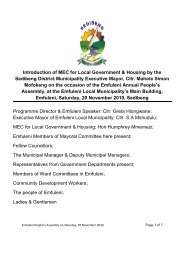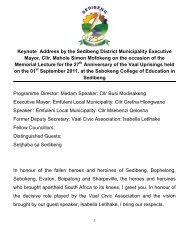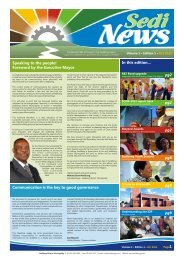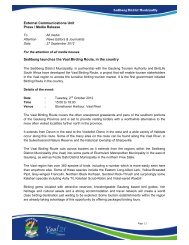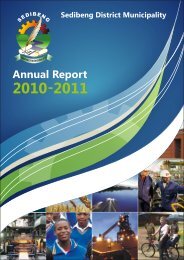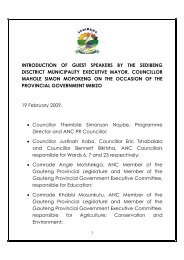Chapter 11 - Sedibeng District Municipality
Chapter 11 - Sedibeng District Municipality
Chapter 11 - Sedibeng District Municipality
You also want an ePaper? Increase the reach of your titles
YUMPU automatically turns print PDFs into web optimized ePapers that Google loves.
The importance of Routine Road Maintenance is generally underestimated in the<br />
preservation of the road infrastructure asset. Inadequate road maintenanc e<br />
increases the cost of repair 6-fold if proper maintenance is delayed for three years,<br />
and 18-fold if proper maintenance is delayed for five years. Further, when a road is<br />
not maintained and is allow ed to deteriorate from a good to a very poor condition,<br />
each rand saved on road maintenance increases vehicle operating costs by between<br />
R2/km and R3/km.<br />
(c)<br />
Strategy<br />
Routine Roads Maintenance<br />
The South African National Roads Agency Limited (SANRAL) in September 2008<br />
published the Routine Road Maintenance Manual. The content of this Manual applies<br />
also to <strong>Sedibeng</strong>.<br />
SANRAL recently revised its Routine Road Maintenance Guidance Manual (2000).<br />
The revised Manual (2008) is based on feedback and lessons learnt from Engineers,<br />
Route Managers, Contractors and Sub-contractors on routine road maintenanc e<br />
contracts over the last decade.<br />
The primary objective of the Routine Road Maintenance Manual is a tool to guide the<br />
Site Management Team (Client, Consultant and Contractor) in the efficient<br />
management of the routine road maintenance contracts, accurate identification of<br />
problems / shortcomings, selecting appropriate and cost effective actions and / or<br />
repair methods, and maintaining the functions integrity of the road netw ork.<br />
SDM w ill take corrective action not only to promote a safe and efficient road netw ork,<br />
but also to protect the environment in its jurisdictional area by encouraging its Local<br />
Municipalities to adhere to the requirements and guidelines contained in the Routine<br />
Road Maintenance Manual published by SANRAL in September 2008.<br />
Warrants for Upgrading Roads<br />
This section contains some criteria or w arrants about w hen to apply road<br />
maintenance. The primary source document used is TMH 9: 1992. Pavement<br />
Management Systems: Standard Visual Assessment Manuel for Flexible Pavements,<br />
dated December 1992. The practices expressed in this document are particularly<br />
relevant to a rural area context.<br />
Below is a description or general rating of the overall condition of the pavement.<br />
Degree<br />
Very good<br />
Good<br />
Fair<br />
Poor<br />
Very poor<br />
Description<br />
Very few or no defects. Degree of defects < 3 (less than w arning).<br />
Few defects. Degree of structural defects mostly less than w arning.<br />
A few defects with degree of defects seldom severe. Extent is only<br />
local if degree is severe (excluding surfacing defects).<br />
General occurrence of particular structural defects with degrees<br />
warning to severe.<br />
Many defects. The degree of the majority of the structural defects is<br />
severe and the extent is predominantly general to extensive.<br />
Below is a discussion of the possible treatments on a road segment.<br />
SDM DITP, 2008 to 2013 142 31 Aug 2010



